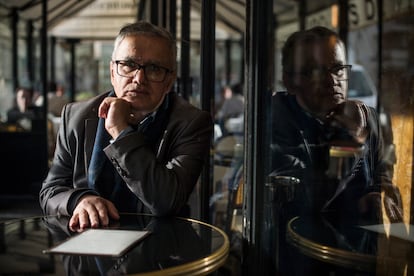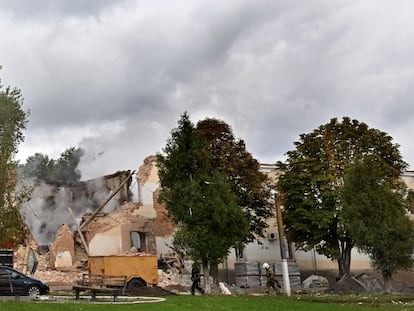‘There is no going back’ on Iranian protests, says exiled writer Taghi Rahmani
Described by Reporters Without Borders as Iran’s most frequently jailed journalist, he is certain that the only way forward is the overthrow of the regime


Taghi Rahmani, 63, set foot in prison for the first time at the age of 15, under the despotic monarchy of the last Shah of Iran. From then until 2012, when he went into exile in France, this intellectual was constantly in and out of prison, where he spent a combined total of over 16 years. In 2011, Reporters Without Borders defined him as “Iran’s most frequently jailed journalist” for criticizing the Islamic Republic that has ruled his country since 1979.
In 2015, Rahmani’s twin sons, now 16, met with him in Paris. Their mother, the journalist Narges Mohammadi, 50, had just been jailed in Iran. Mohammadi is still in prison, where she is serving a series of sentences. She has not seen her children for seven years, and for the last seven months has not even been allowed to speak to them on the phone, her husband explained in a video call with this newspaper from Paris on Thursday of last week.
Rahmani does not regret the price that his family has paid for their fight. His wife, he says, has even fewer regrets: “She is more firm than me in terms of our ideals.”
Question. How do you view the current protests in Iran?
Answer. A Persian proverb says that the rope breaks at its narrowest point. After 43 years of injustice, the regime has stretched that rope too tight due to its discrimination against women, ethnic and religious minorities; also because of its unbearable repression and widespread corruption, which have plunged Iranians into abject poverty. Hence the motto “Woman, Life, Freedom”: woman, because Iranian women are suffering from Stone Age norms; life, because in Iran there are many people who cannot earn a living and, lastly, freedom, because freedom and justice is what we lack the most. What happened to Mahsa Amini [the young woman who died in police custody on September 16 after being arrested for wearing the veil improperly] was just the fuse. The protests are directed against the entire regime.
Q. Are women the narrow part of that rope?
A. They are the most intensely affected by the terrible discrimination with which this theocracy treats anyone who does not adhere to their Shiite fundamentalist values. The Islamic Republic persecutes ethnic, religious and sexual minorities, but women suffer from systemic discrimination. It is often said that 60% of Iranian university students are women, and it is true, but Iranian women are absent from the bodies of power. In parliament, there are 299 seats and only nine are occupied by women, who of course are sympathetic to the regime and are not there to defend Iranian women, but to further discriminate against them.
Q. What makes these protests different from those of the past?
A. There have always been protests in Iran, but the previous ones mostly attracted dispossessed Iranians from the cities’ peripheries and also from the regions, such as the area where the Kurds live. A very big difference about these protests is the involvement of the middle classes and university students. The regime itself has understood its mistake by not closing the universities. Another new element is the persistence of the demonstrations and the fact that a population that this fundamentalist system has tried to divide by all means, appealing to ethnicity, religion, even different professions, is now shouting in unison “From Tehran to Kurdistan, I offer my life for freedom.”
Q. What does the persistence of the demonstrations represent?
A. [Ayatollah] Khamenei [Iran’s supreme leader] is very concerned, especially since the forces of repression are becoming depleted [448 Iranians have died from the repression in Iran, according to the NGO Iran Human Rights, or 300 according to the only known official figure]. The regime was not expecting this. Documents obtained by hackers have been released, in which the authorities express their fear that they will not have sufficient means to continue repressing the protests. Even the regime itself knows that the vast majority of Iranians, 80% according to those documents, want change. Not all of them are taking to the streets, due to the brutality of the crackdown and the fear, but they do share the ideals of the protesters. The remaining 20% are people who have a vested interest in the survival of this regime.
Q. Do you think the protests can be stopped?
A. I think there is no going back. The Iranians have broken their ties with this regime. We are experiencing the genesis of a revolution that, to succeed, needs to be imposed in five areas: cultural, social, economic, legislative and political. In the first two, the revolution has already been completed. If there were any breaks in the mobilization, it would be only to resurface again, given the extent of popular discontent. The only thing that could slow down, but not stop, the protests would be if the theocracy managed to inject a large amount of money that would improve the daily life of the population, but the regime does not have that kind of economic capacity.
Q. What scenario could open up with the death of Khamenei, who is 83 years old? A Revolutionary Guard coup?
A. Khamenei is a blocking element, preventing any possibility of change. The only way is the overthrow of the regime. The Revolutionary Guard Corps and the Islamic Republic are one and the same. A coup could not make the situation worse. In Iran, the core of power right now is made up of Khamenei, his son [Mojtaba], the head of the judiciary, the head of the intelligence services and the Revolutionary Guard. If Khamenei imposes his son, who is weaker than him, as his successor, and the people continue to resist, the protest will have more force. Khamenei has four red lines: the first is the vision of the United States as an enemy; the second, the rejection of the leaders of the Green Movement of 2009 [Mir Hosein Mousavi and Mehdi Karrubí]; the third, control over the Guardian Council [the body with the power to veto laws and presidential candidates]; and the fourth, the obligatory nature of the Islamic veil. If, when Khamenei dies, those red lines are maintained, there will be no change on the part of the regime.
Q. What has happened to the reformists in Iran?
A. Many reformist Iranians have given up all hope that this theocracy will evolve and now want regime change. Some are in prison for having participated in the current protests.
Q. What do the Iranians demand from the West?
A. Europe’s interest is to support the Iranian democratic movement. The West should not seek to fix its problems with the theocracy in Iran by focusing on the nuclear [deal], but rather support our revolution. Right now, we need your help to force the regime to quash the death sentences of [at least six] protesters.
Sign up for our weekly newsletter to get more English-language news coverage from EL PAÍS USA Edition
Tu suscripción se está usando en otro dispositivo
¿Quieres añadir otro usuario a tu suscripción?
Si continúas leyendo en este dispositivo, no se podrá leer en el otro.
FlechaTu suscripción se está usando en otro dispositivo y solo puedes acceder a EL PAÍS desde un dispositivo a la vez.
Si quieres compartir tu cuenta, cambia tu suscripción a la modalidad Premium, así podrás añadir otro usuario. Cada uno accederá con su propia cuenta de email, lo que os permitirá personalizar vuestra experiencia en EL PAÍS.
¿Tienes una suscripción de empresa? Accede aquí para contratar más cuentas.
En el caso de no saber quién está usando tu cuenta, te recomendamos cambiar tu contraseña aquí.
Si decides continuar compartiendo tu cuenta, este mensaje se mostrará en tu dispositivo y en el de la otra persona que está usando tu cuenta de forma indefinida, afectando a tu experiencia de lectura. Puedes consultar aquí los términos y condiciones de la suscripción digital.
More information
Archived In
Últimas noticias
Most viewed
- Sinaloa Cartel war is taking its toll on Los Chapitos
- Oona Chaplin: ‘I told James Cameron that I was living in a treehouse and starting a permaculture project with a friend’
- Reinhard Genzel, Nobel laureate in physics: ‘One-minute videos will never give you the truth’
- Why the price of coffee has skyrocketed: from Brazilian plantations to specialty coffee houses
- Silver prices are going crazy: This is what’s fueling the rally










































